| | |
|---|---|
| Overview | |
| Locale | Berlin |
| Service | |
| System | Berlin S-Bahn |
| Operator(s) | S-Bahn Berlin GmbH |
| Technical | |
| Electrification | 750 V DC Third rail |
The S86 was a line number used by the Berlin S-Bahn.
| | |
|---|---|
| Overview | |
| Locale | Berlin |
| Service | |
| System | Berlin S-Bahn |
| Operator(s) | S-Bahn Berlin GmbH |
| Technical | |
| Electrification | 750 V DC Third rail |
The S86 was a line number used by the Berlin S-Bahn.
This line number has been associated with four different routes during the last fifteen years.
The first version of the S86 was created on 2 June 1991, replacing the Brown route of the East Berlin S-Bahn between Buch and Warschauer Straße (via the eastern part of the Ringbahn). [1] [2]
The line was altered in May 1993 to run between Pankow and Hauptbahnhof (now Ostbahnhof), before being abolished in May 1994.
The line re-appeared as a night-time shuttle between Hermannstraße and Spindlersfeld in December 1999 before being removed again in June 2002. The line was re-introduced temporarily during construction works between September 2005 and May 2006.
Currently there are plans to again re-introduce the line as a permanent addition between Buch and Grünau replacing the S26 and S85, which will only happen if the S85 starts service towards the Central Station (Berlin Hauptbahnhof). [3]
This service ran for two years and provided an increased daytime service between Warschauer Straße and Buch. The line was extensively altered in May 1993 which effectively removed most of this service. The station listing below provides an overview of what the line looked like. The possible travel connections are correct for the period of operation and do not reflect the current travel connections for these stations.
In May 1993, the line was extended by one station to the Hauptbahnhof (now Ostbahnhof) with the northern section cut back to Pankow. This revised line existed for a single year when the line disappeared off the maps for a period of five years. The station listing below provides an overview of what the line looked like. The possible travel connections are correct for the period of operation and do not reflect the current travel connections for these stations.
In December 1999, the line re-appeared as a night-time shuttle service between Spindlersfeld and Hermannstraße. This short line ran between 9pm and 4am to provide Spindlersfeld with a link to the network when the (S85) finished for the night. The line lasted until June 2002 when the new (S47) line started serving Spindlersfeld both day and night rendering the S86 obsolete. The station listing below provides an overview of what the line looked like. The possible travel connections are correct for the period of operation and do not reflect the current travel connections for these stations.
During major construction works at Pankow station and in the north–south tunnel between September 2005 and May 2006, the S86 operated between Nordbahnhof and Birkenwerder to maintain a service to the outer railway ring stations. The line joined with the (S26) at Nordbahnhof for three weeks to provide a through service to Teltow Stadt from 8 May 2006 until 27 May 2006. The possible travel connections are correct for the period of operation and do not reflect the current travel connections for these stations.

Pankow is the most populous and the second-largest borough by area of Berlin. In Berlin's 2001 administrative reform, it was merged with the former boroughs of Prenzlauer Berg and Weißensee; the resulting borough retained the name Pankow. Pankow was sometimes claimed by the Western Allies to be the capital of the German Democratic Republic, while the German Democratic Republic itself considered East Berlin to be its capital.
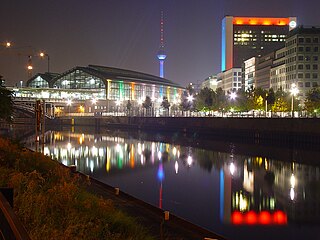
The Berlin S-Bahn is a rapid transit railway system in and around Berlin, the capital city of Germany. It has been in operation under this name since December 1930, having been previously called the special tariff area Berliner Stadt-, Ring- und Vorortbahnen. It complements the Berlin U-Bahn and is the link to many outer-Berlin areas, such as Berlin Brandenburg Airport. As such, the Berlin S-Bahn blends elements of a commuter rail service and a rapid transit system.

U1 is a line on the Berlin U-Bahn, which is 8.8 kilometres (5.5 mi) long and has 13 stations. Its traditional line designation was BII. It runs east–west and its eastern terminus is Warschauer Straße S-Bahn station where it connects to the Schlesische Bahn. From there it runs through Kreuzberg via Gleisdreieck and Wittenbergplatz on to the Kurfürstendamm.

U2 is a line of the Berlin U-Bahn. The U2 line starts at Pankow S-Bahn station, runs through the eastern city centre (Alexanderplatz) to Potsdamer Platz, the western city centre and finally to the Ruhleben terminal station.

U3 is a line on the Berlin U-Bahn created in its current version on 7 May 2018.

S85 is a line on the Berlin S-Bahn. It operates from Grünau to Berlin-Pankow over:
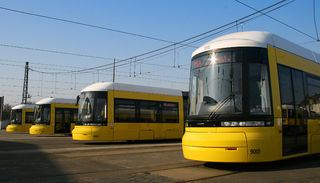
The Berlin tramway is the main tram system in Berlin, Germany. It is one of the oldest tram networks in the world having its origins in 1865 and is operated by Berliner Verkehrsbetriebe (BVG), which was founded in 1929. It is notable for being the third-largest tram system in the world, after Melbourne and St. Petersburg. Berlin's tram system is made up of 22 lines that operate across a standard gauge network, with almost 800 stops and measuring almost 190 kilometres (120 mi) in route length and 430 kilometres (270 mi) in line length. Nine of the lines, called Metrotram, operate 24 hours a day and are identified with the letter "M" before their number; the other thirteen lines are regular city tram lines and are identified by just a line number.
S26 is a line on the Berlin S-Bahn. It runs from Teltow in the district (Kreis) of Potsdam-Mittelmark via Südkreuz, through the Berlin Nord-Süd Tunnel with a stop at Friedrichstraße, and ends in Waidmannslust in the borough of Reinickendorf. On weekends the S26 runs from Teltow to Potsdamer Platz.

Berlin-Lichtenberg is a railway station in Berlin, Germany. It is located on the Eastern Railway, Wriezen Railway and Berlin Frankfurter Allee–Berlin-Rummelsburg railway lines in the Lichtenberg district. The station is also part of the Berlin S-Bahn and U-Bahn network.

The S10 was a line number used by the Berlin S-Bahn from June 1991 until December 1999. The line operated solely in the former East Berlin and was replaced by the S8 for the northern part of the route and the S47/S9 for the southern routing.
The S6 was a line number used by the Berlin S-Bahn from June 1991 until June 2002. The line always ran to the south-east corner of Berlin, although a number of routings were used during its period of operation. The line was replaced by the S46 and S8 which now provide connections to south-east Berlin.
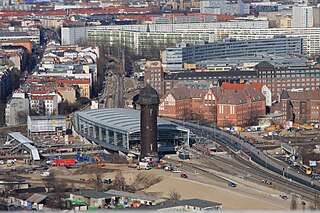
Berlin Ostkreuz station is a station on the Berlin S-Bahn suburban railway and the busiest interchange station in Berlin. It is in the former East Berlin district of Friedrichshain, now part of the borough of Friedrichshain-Kreuzberg. A smaller part of the station is in Rummelsburg, part of the borough of Lichtenberg. The station is a Turmbahnhof with the Berlin–Frankfurt (Oder) railway and the Prussian Eastern Railway on the lower level and the Berlin Ringbahn on the upper level. It is used by a total of around 235,000 passengers every day on eight lines, entering or leaving.

The Ringbahn is a 37.5 km (23.3 mi) long circle route around Berlin's inner city area, on the Berlin S-Bahn network. Its course is made up of a pair of tracks used by S-Bahn trains and another parallel pair of tracks used by various regional, long distance and freight trains. The S-Bahn lines S41 and S42 provide a closed-loop continuous service without termini. Lines S45, S46 and S47 use a section of the southern and western ring, while lines S8 and S85 use sections of the eastern ring. The combined number of passengers is about 400,000 passengers a day. Due to its distinctive shape, the line is often referred to as the Hundekopf.

Berlin Gesundbrunnen station is a railway station in Berlin, Germany. It is situated in the Gesundbrunnen district, part of the central Mitte borough, as an interconnection point between the northern Ringbahn and Nord-Süd Tunnel lines of the Berlin S-Bahn, as well as a regional and long distance station of the Deutsche Bahn network. The station is operated by the DB Station&Service subsidiary of Deutsche Bahn AG and is classified as a Category 1 station, one of 21 in Germany and four in Berlin, the others being Berlin Hauptbahnhof, Berlin Südkreuz and Berlin Ostbahnhof.
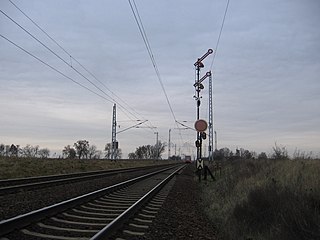
The Berlin Northern Railway is a 223-kilometre-long main line route, that runs from Berlin via Neustrelitz and Neubrandenburg to Stralsund on the Baltic Sea coast. Nowadays, long-distance and regional traffic on the Nordbahn is routed at Hohen Neuendorf onto the Berlin Outer Ring to the Karower Kreuz and on to Berlin Main Station or Berlin-Lichtenberg.
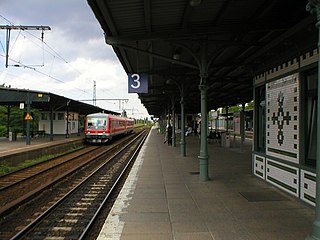
Berlin-Schöneweide is a railway station in Niederschöneweide, part of the Treptow-Köpenick borough of Berlin. It is served by the S-Bahn and regional trains, buses and trams. It was a terminal for long-distance trains until 2011.

Bus transport is the oldest public transport service in Berlin, the capital city of Germany, having been introduced in 1846. Since 1929, services have been operated by the Berlin Transport Company, although during the Cold War-era division of the city they operated in West Berlin only. In East Berlin the public transport agency split off from the BVG and rebranded as BVB, operating the busses in the soviet sector of Berlin.

S21 is a planned second north-south route for the Berlin S-Bahn, which will connect Berlin Hauptbahnhof to the Berlin Ringbahn to both north and south. The first section is under construction and is expected to go into operation in December 2022.
The Berlin Frankfurter Allee–Berlin-Rummelsburg railway is an electrified line in Berlin. It connects the Ringbahn with the Berlin-Betriebsbahnhof Rummelsburg station. Except for a short section, the line has two tracks. It was originally created as a freight line, but it is now used primarily used for the transfer of empty passenger trains that are maintained at the Rummelsburg depot. The track is also linked by a double-track line from the Ringbahn from the south to the Berlin-Lichtenberg station.

The Berlin U-Bahn originated in 1880 with Werner Siemens' idea to build an urban railway in Berlin. During the nine years after the German Empire was founded, the city's population grew by over one-third and traffic problems increased. In 1896, Siemens & Halske began to construct the first stretch of overhead railway. On 1 April 1897, the company began construction of an electric underground railway. The Berliner Verkehrs Aktiengesellschaft (BVG) was formed in 1928, and took over further construction and operation of the network. In 1938, the company was renamed Berlin Transport Company; the original acronym, however, remained. Since 1994, the BVG has been a public company.